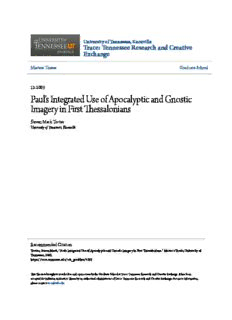
Paul's Integrated Use of Apocalyptic and Gnostic Imagery in First Thessalonians PDF
Preview Paul's Integrated Use of Apocalyptic and Gnostic Imagery in First Thessalonians
UUnniivveerrssiittyy ooff TTeennnneesssseeee,, KKnnooxxvviillllee TTRRAACCEE:: TTeennnneesssseeee RReesseeaarrcchh aanndd CCrreeaattiivvee EExxcchhaannggee Masters Theses Graduate School 12-2005 PPaauull''ss IInntteeggrraatteedd UUssee ooff AAppooccaallyyppttiicc aanndd GGnnoossttiicc IImmaaggeerryy iinn FFiirrsstt TThheessssaalloonniiaannss Steven Mack Trotter University of Tennessee, Knoxville Follow this and additional works at: https://trace.tennessee.edu/utk_gradthes Part of the Philosophy Commons RReeccoommmmeennddeedd CCiittaattiioonn Trotter, Steven Mack, "Paul's Integrated Use of Apocalyptic and Gnostic Imagery in First Thessalonians. " Master's Thesis, University of Tennessee, 2005. https://trace.tennessee.edu/utk_gradthes/4593 This Thesis is brought to you for free and open access by the Graduate School at TRACE: Tennessee Research and Creative Exchange. It has been accepted for inclusion in Masters Theses by an authorized administrator of TRACE: Tennessee Research and Creative Exchange. For more information, please contact [email protected]. To the Graduate Council: I am submitting herewith a thesis written by Steven Mack Trotter entitled "Paul's Integrated Use of Apocalyptic and Gnostic Imagery in First Thessalonians." I have examined the final electronic copy of this thesis for form and content and recommend that it be accepted in partial fulfillment of the requirements for the degree of Master of Arts, with a major in Philosophy. David Dungan, Major Professor We have read this thesis and recommend its acceptance: David Linge, Charles Reynolds Accepted for the Council: Carolyn R. Hodges Vice Provost and Dean of the Graduate School (Original signatures are on file with official student records.) Tot hGer adCuoautnec il: Ia ms ubmihtetrieanwt gih tewhsr iist tSetneM vabecynTk r oetntteir"t Plaeudl,' s InteUgsroeafA t peodc aanldypG tniocsI tmiacgi eFnri yTr hsets salIho anviean s." examtihnfieen dpa alp ceorpo ytfh tihsefo srfoi rsman dc onantder netc omtmheantd ibtea cceippntar etdfui lafill lomtfe hrneet q uirfoertm hdeeen grtoesfMe a sotfe r Arts,a m waijitoPnhrh ilosophy. � L�. i --- DavDiudn gMana,jP orro fesso Weh avet hrtiehsae ds is an�;:; z; :¥ a DavLiidn ge ChaRreyilOlf<ise s ViCceh anceanldl or DeaonfGr aduSattued ies PAUL'S INTEGRATED USE OF APOCALYPTIC AND GNOSTIC IMAGERY IN FIRST THESSALONIANS A Thesis Presented for the Master of Arts Degree The University of Tennessee Steven Mack Trotter December 2005 Copyright© 2005 by Steven Mack Trotter All rights reserved. 11 DEDICATION This thesis is dedicated to my parents, Marion Gose Trotter (t 2003) and Troy Columbus Trotter. On October 13, 1962, my parents presented to me the New Testament/Psalms wherein was inscribed: "This is to you, our darling little boy. May the teachings of this book and the Love of God always be with you. Mother" During my childhood and continuing into adulthood, I have always experienced the encouragement, love, and support of my parents. Truly, I was blessed to have such wonderful parents. lll ACKNOWLEDGMENTS I would like to express my sincere gratitude to members of my committee: Drs. David L. Dungan, David E. Linge, and Charles H. Reynolds for their support throughout my participation in the graduate program and their service on my graduate committee. As an undergraduate student at The University of Tennessee in the mid-1970's, I enrolled in a world religions course taught by Dr. Linge. I still vividly remember many of the dynamic lectures given by him. Of all my undergraduate teachers, he is the most memorable. Simply put, he was the best. As I contemplated returning to The University to pursue studies in early Christianity, I contacted Dr. Linge who agreed to meet with me to discuss the graduate program in Religious Studies. The warm welcome and strong encouragement received from him essentially led to my applying for admission to the program. I am grateful for his encouragement and support across the years. In seeking admission to the graduate program, I met with Dr. Reynolds, who was then Head of the Department of Religious Studies. Dr. Reynolds welcomed me into the graduate program, and continued to provide advice, encouragement, and support as both an administrator and teacher. I am extremely fortunate to have had him for coursework in Christian ethics, as he is responsible for my introduction to the writings of H. Richard and Reinhold Niebuhr, as well as the writings of many contemporary Christian ethicists. Prior to entering the graduate program, I met with Dr. Dungan regarding my interests in early Christianity. Dr. Dungan kindly received me into his office, patiently listened to me describe my interests, provided me with an article to read, and suggested that after reading the article, I should return so we could further discuss the subject. In V many ways, this became characteristic of our relationship. I am extremely grateful to Dr. Dungan for his receptiveness to my myriad questions, for his guiding hand as I pursued studies under his direction, for the countless hours he spent in support of development and completion of this thesis, and for his unceasing encouragement during the past six years. I am extremely fortunate to have had him for a major professor, and mere words do not adequately convey the admiration, respect, and appreciation I have for him. I also wish to thank Mrs. Debbie Myers and Mrs. Joan Riedl, the department secretaries for the Department of Religious Studies. They always greeted me with warm, friendly smiles, and ensured that I was able to schedule timely appointments with faculty members and that I was abreast of forthcoming seminars, special events, and departmental social gatherings. Finally, I wish to extend appreciation to my wife, Kimberly D. Gwinn, and our son, Luke Trotter. They are a constant source of encouragement, support, and love, and perhaps more importantly, it is through them that I continuously learn what is truly important in life. VI
Description: